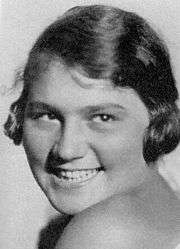Geli Raubal
| Geli Raubal | |
|---|---|
 | |
| Born |
Angela Maria Raubal 4 June 1908[1] Linz, Austria-Hungary[1] |
| Died |
18 September 1931 (aged 23)[2] Munich, Germany[2] |
| Cause of death | Suicide[1] |
| Resting place | Zentralfriedhof, Vienna, Austria |
| Nationality | Austro-Hungarian, Austrian |
| Alma mater | Ludwig Maximilian University |
| Known for | Adolf Hitler's half-niece |
| Parent(s) |
Leo Raubal Angela Raubal (née Hitler) |
| Relatives | See: Hitler family |
Angela Maria "Geli" Raubal ([ˈɡeːliː ˈʀaʊ̯bal]; 4 June 1908 – 18 September 1931) was Adolf Hitler's half-niece. Born in Linz, Austria-Hungary, she was the second child and eldest daughter of Leo Raubal Sr. and Hitler's half-sister, Angela Raubal. Raubal lived in close contact to her uncle from 1925 until her presumed suicide in 1931.
Life
Angela Maria "Geli" Raubal was born in Linz,[1] where she grew up with her brother, Leo, and a sister, Elfriede. Her father died at the age of 31, when Geli was two. She and Elfriede accompanied their mother when she became Hitler's housekeeper in 1925; Raubal was 17 at the time and spent the next six years in close contact with her half-uncle,[3] who was 19 years her senior. Her mother was given a position as housekeeper at the Berghof villa near Berchtesgaden in 1928.[4] Raubal moved into Hitler's Munich apartment in 1929 when she enrolled in medicine at Ludwig Maximilian University. She did not complete her medical studies.[1]
As he rose to power as leader of the Nazi Party, Hitler was domineering and possessive of Raubal, keeping a tight rein on her.[5] When he discovered she was having a relationship with his chauffeur, Emil Maurice, he forced an end to the affair and dismissed Maurice from his service.[1][6] After that he did not allow her to freely associate with friends, and attempted to have himself or someone he trusted near her at all times, accompanying her on shopping trips, to the movies, and to the opera.[5]
Death
Raubal was in effect a prisoner, but planned to escape to Vienna to continue her singing lessons.[3] Her mother told interrogators after the war that her daughter was hoping to marry a man from Linz, but that Hitler had forbidden the relationship. He and Raubal argued on 18 September 1931—he refused to allow her to go to Vienna. He departed for a meeting in Nuremberg, but was recalled to Munich the next day: Raubal was dead from a gunshot wound to the lung;[1] she had apparently shot herself in Hitler's Munich apartment with Hitler's Walther pistol.[6] She was 23.
Rumours immediately began in the media about physical abuse, a possible sexual relationship, and even murder.[1][7] Otto Strasser, a political opponent of Hitler, was the source of some of the more sensational stories. The historian Ian Kershaw maintains that "whether actively sexual or not, Hitler's behaviour towards Geli has all the traits of a strong, latent at least, sexual dependence."[5] The police ruled out foul play; the death was ruled a suicide.[8] Hitler was devastated and went into an intense depression. He took refuge at a house on the shores of Tegernsee lake, and did not attend the funeral in Vienna on 24 September. He visited her grave at Vienna's Zentralfriedhof (Central Cemetery) two days later. Thereafter, he overcame his depression and refocused on politics.[7]
Hitler later declared that Raubal was the only woman he had ever loved. Her room at the Berghof was kept as she had left it, and he hung portraits of her in his own room there and at the Chancellery in Berlin.[9]
Media portrayals
- Raubal is portrayed by Poldi Dur in The Hitler Gang (1944); by Cordula Trantow in Hitler (1962); by Jena Malone in the miniseries Hitler: The Rise of Evil (2003); and by Elaine Cassidy in the television film Uncle Adolf (2005).
See also
References
Notes
- 1 2 3 4 5 6 7 8 Görtemaker 2011, p. 43.
- 1 2 Kershaw 2008, p. 218.
- 1 2 Bullock 1999, p. 393.
- ↑ Kershaw 2008, p. 177.
- 1 2 3 Kershaw 2008, p. 219.
- 1 2 Kershaw 2008, p. 220.
- 1 2 Kershaw 2008, p. 221.
- ↑ Shirer 1960, p. 132.
- ↑ Shirer 1960, pp. 132–133.
Bibliography
- Bullock, Alan (1999) [1952]. Hitler: A Study in Tyranny. New York: Konecky & Konecky. ISBN 978-1-56852-036-0.
- Görtemaker, Heike B. (2011). Eva Braun: Life with Hitler. New York: Alfred A. Knopf. ISBN 978-0-307-59582-9.
- Kershaw, Ian (2008). Hitler: A Biography. New York: W. W. Norton & Company. ISBN 978-0-393-06757-6.
- Shirer, William L. (1960). The Rise and Fall of the Third Reich. New York: Simon & Schuster. ISBN 978-0-671-62420-0.
Further reading
- Alexander, Alex (2005). In de ban van Hitler: Maria Reiter, Geli Raubal, Unity Mitford, Eva Braun (in Dutch). Rijswijk: Elmar. ISBN 978-90-389-1547-0.
- Hayman, Ronald (1998) [1997]. Hitler & Geli. New York: Bloomsbury. ISBN 978-1-58234-008-1.
- Rosenbaum, Ron (1998). Explaining Hitler: The Search for the Origins of his Evil. New York: Random House. ISBN 978-0-679-43151-0.
- Strasser, Otto (1940). Hitler and I. Boston: Houghton Mifflin. ISBN 978-0-404-16997-8.
- Vermeeren, Marc (2007). De jeugd van Adolf Hitler 1889–1907 en zijn familie en voorouders (in Dutch). Soesterberg: Aspekt. ISBN 978-90-5911-606-1.